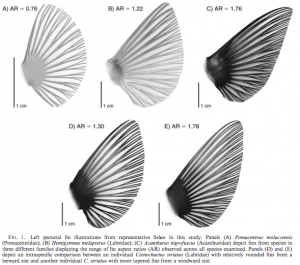“Adaptation” is a term that everyone is familiar with. In the scientific community, it refers to a change or the process of change by which an organism or species becomes better suited to its environment. Because of the diversity between environments, advantageous traits that are naturally selected for diverge greatly even within a species. In response to this, researchers are seeking to better understand the associations between organisms’ morphologies and habitats. This way, they can illuminate the causal factors of selection pressures, elucidate the significance of current differences, and predict future selection patterns.
Recently, researchers Sandra Binning and Dominique Roche investigated the relationship between oceanic water flow and fin shape of twelve widespread species from three families of fish: Acanthuridae, Labridae, and Pomacentridae. Previous studies have suggested that water flow influences patterns of intraspecific variation of body structure in freshwater species.
Acanthurus nigrofuscus (family Acanthuridae)

Labridae prague (family Labridae)

Acanthochromis polyacanthus (family Pomacentridae)
For fish, body shape and fin shape greatly affect their ability to survive in high water flow environments. Generally, fish with tapered, high aspect ratio pectoral fins are associated with efficiency in high-speed swimming in high water flow environments, and fish wish rounded, low aspect ratio pectoral fins are associated with efficiency with more sheltered, low water flow environments (see Figure 1, reproduced from their publication.)
The study took place around Lizard Island, on the Northern Great Barrier Reef, Australia. Binning and Roche wanted to test how closely fin and body shape are related to water flow. They predicted that fish residing in high water flow areas would have fins with greater aspect ratios with smaller (“finer”) body types, and they also predicted that species that have varying body morphologies (polymorphic species) should have individuals equally distributed across varying water flow environments, whereas species that did not have variance in body morphology (non-polymorphic species) should reside in the location best suited to their body type.
Binning and Roche generally found that fish collected from high water flow areas had tapered fins with greater aspect ratios, whereas fish collected from sheltered habitats with low water flow had rounder fins. They further observed that there was no correlation between body fineness and wave habitat in any of the species; however, species from the Acanthuridae and Labridae families had higher aspect ratio fins at windward (high water flow) than leeward (low water flow) sites. This relationship was also observed in three of the seven Pomacentridae species. The researchers found that the abundance of species differed between water flow habitats, but they did not observe an equal distribution of polymorphic species across varying habitats.
The researchers interpreted these data to suggest that fin morphology and water flow patterns are related since the association was seen across the majority of the species observed. However, the findings do not suggest a directional relationship. Also, the researchers did not observe the predicted abundance patterns, which led them to posit that there may be alternative behavioral and/or physiological mechanisms that allow some species to survive in flow environments regardless of polymorphic characteristics.
This research not only provides insight to the specific relationship between fin morphology and water flow pattern across twelve species of fish, but it also expands the field to the possibility of previously uninvestigated channels of adaptation within these species. Additionally, Binning and Roche increased the knowledge of the relationship between habitat and morphology and the origins of biodiversity within and between species.
Reference: Binning SA & Roche DG. (2015) Water flow and fin ship polymorphism in coral reef fish. Ecology, 96(3); 828-839.

